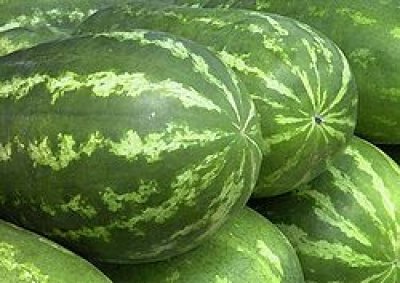Watermelon
 Watermelon is a tender, warm-season vegetable. Watermelons can be grown in all parts of the country, but the warmer temperatures and longer growing season of southern areas especially favor this vegetable. Gardeners in northern areas should choose early varieties and use transplants. Mulching with black plastic film also promotes earliness by warming the soil beneath the plastic. Floating row covers moderate temperatures around the young plants, providing some frost protection in unseasonable cold spells.
Watermelon is a tender, warm-season vegetable. Watermelons can be grown in all parts of the country, but the warmer temperatures and longer growing season of southern areas especially favor this vegetable. Gardeners in northern areas should choose early varieties and use transplants. Mulching with black plastic film also promotes earliness by warming the soil beneath the plastic. Floating row covers moderate temperatures around the young plants, providing some frost protection in unseasonable cold spells.
Seedless watermelons are self-sterile hybrids that develop normal-looking fruits but no fully developed seeds. The seeds for growing them are produced by crossing a normal diploid watermelon with one that has been changed genetically into the tetraploid state. The seeds from this cross produce plants that, when pollinated by normal plants, produce seedless melons.
In seedless watermelons (genetic triploids), rudimentary seed structures form but remain small, soft, white, tasteless and undeveloped tiny seedcoats that are eaten virtually undetected along with the flesh of the melon. Seed production for these seedless types is an extremely labor intensive process that makes the seeds relatively expensive. Because germination of these types is often less vigorous than normal types, it is recommended that they be started in peat pots or other transplantable containers, where the germinating conditions can be closely controlled Once transplanted, cultivation is similar to that for regular watermelons.
For pollination necessary to set fruit, normal seed types must be interplanted with seedless melons. The pollinator should be distinct from the seedless cultivar in color, shape or type so that the seedless and seeded melons in the patch can be separated at harvest. Because seedless types do not put energy into seed production, the flesh is often sweeter than normal types and the vines are noticeably more vigorous as the season progresses.